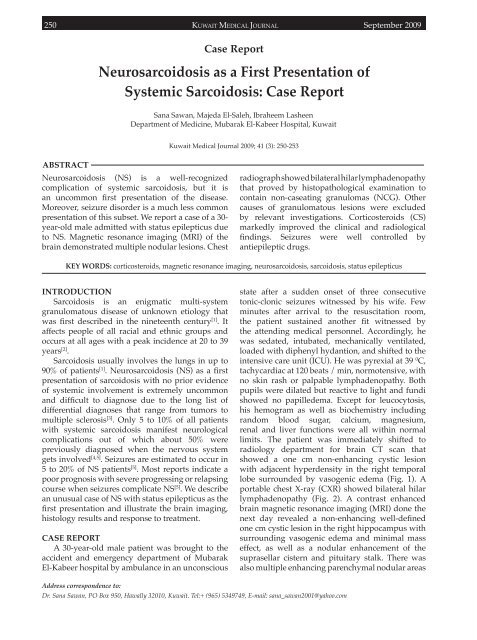Vol 41 # 3 September 2009 - Kma.org.kw
Vol 41 # 3 September 2009 - Kma.org.kw
Vol 41 # 3 September 2009 - Kma.org.kw
Create successful ePaper yourself
Turn your PDF publications into a flip-book with our unique Google optimized e-Paper software.
250<br />
KUWAIT MEDICAL JOURNAL <strong>September</strong> <strong>2009</strong><br />
Case Report<br />
Neurosarcoidosis as a First Presentation of<br />
Systemic Sarcoidosis: Case Report<br />
Sana Sawan, Majeda El-Saleh, Ibraheem Lasheen<br />
Department of Medicine, Mubarak El-Kabeer Hospital, Kuwait<br />
Kuwait Medical Journal <strong>2009</strong>; <strong>41</strong> (3): 250-253<br />
ABSTRACT<br />
Neurosarcoidosis (NS) is a well-recognized<br />
complication of systemic sarcoidosis, but it is<br />
an uncommon first presentation of the disease.<br />
Moreover, seizure disorder is a much less common<br />
presentation of this subset. We report a case of a 30-<br />
year-old male admitted with status epilepticus due<br />
to NS. Magnetic resonance imaging (MRI) of the<br />
brain demonstrated multiple nodular lesions. Chest<br />
radiograph showed bilateral hilar lymphadenopathy<br />
that proved by histopathological examination to<br />
contain non-caseating granulomas (NCG). Other<br />
causes of granulomatous lesions were excluded<br />
by relevant investigations. Corticosteroids (CS)<br />
markedly improved the clinical and radiological<br />
findings. Seizures were well controlled by<br />
antiepileptic drugs.<br />
KEY WORDS: corticosteroids, magnetic resonance imaging, neurosarcoidosis, sarcoidosis, status epilepticus<br />
INTRODUCTION<br />
Sarcoidosis is an enigmatic multi-system<br />
granulomatous disease of unknown etiology that<br />
was first described in the nineteenth century [1] . It<br />
affects people of all racial and ethnic groups and<br />
occurs at all ages with a peak incidence at 20 to 39<br />
years [2] .<br />
Sarcoidosis usually involves the lungs in up to<br />
90% of patients [1] . Neurosarcoidosis (NS) as a first<br />
presentation of sarcoidosis with no prior evidence<br />
of systemic involvement is extremely uncommon<br />
and difficult to diagnose due to the long list of<br />
differential diagnoses that range from tumors to<br />
multiple sclerosis [3] . Only 5 to 10% of all patients<br />
with systemic sarcoidosis manifest neurological<br />
complications out of which about 50% were<br />
previously diagnosed when the nervous system<br />
gets involved [4,5] . Seizures are estimated to occur in<br />
5 to 20% of NS patients [5] . Most reports indicate a<br />
poor prognosis with severe progressing or relapsing<br />
course when seizures complicate NS [5] . We describe<br />
an unusual case of NS with status epilepticus as the<br />
first presentation and illustrate the brain imaging,<br />
histology results and response to treatment.<br />
CASE REPORT<br />
A 30-year-old male patient was brought to the<br />
accident and emergency department of Mubarak<br />
El-Kabeer hospital by ambulance in an unconscious<br />
state after a sudden onset of three consecutive<br />
tonic-clonic seizures witnessed by his wife. Few<br />
minutes after arrival to the resuscitation room,<br />
the patient sustained another fit witnessed by<br />
the attending medical personnel. Accordingly, he<br />
was sedated, intubated, mechanically ventilated,<br />
loaded with diphenyl hydantion, and shifted to the<br />
intensive care unit (ICU). He was pyrexial at 39 0 C,<br />
tachycardiac at 120 beats / min, normotensive, with<br />
no skin rash or palpable lymphadenopathy. Both<br />
pupils were dilated but reactive to light and fundi<br />
showed no papilledema. Except for leucocytosis,<br />
his hemogram as well as biochemistry including<br />
random blood sugar, calcium, magnesium,<br />
renal and liver functions were all within normal<br />
limits. The patient was immediately shifted to<br />
radiology department for brain CT scan that<br />
showed a one cm non-enhancing cystic lesion<br />
with adjacent hyperdensity in the right temporal<br />
lobe surrounded by vasogenic edema (Fig. 1). A<br />
portable chest X-ray (CXR) showed bilateral hilar<br />
lymphadenopathy (Fig. 2). A contrast enhanced<br />
brain magnetic resonance imaging (MRI) done the<br />
next day revealed a non-enhancing well-defined<br />
one cm cystic lesion in the right hippocampus with<br />
surrounding vasogenic edema and minimal mass<br />
effect, as well as a nodular enhancement of the<br />
suprasellar cistern and pituitary stalk. There was<br />
also multiple enhancing parenchymal nodular areas<br />
Address correspondence to:<br />
Dr. Sana Sawan, PO Box 950, Hawally 32010, Kuwait. Tel:+ (965) 5349749, E-mail: sana_sawan2001@yahoo.com
















